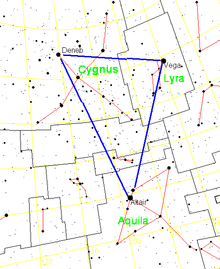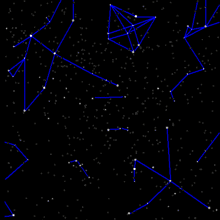Summer Triangle

The Summer Triangle is an astronomical asterism in the northern celestial hemisphere. The defining vertices of this imaginary triangle are at Altair, Deneb, and Vega, each of which is the brightest star of its constellation (Aquila, Cygnus, and Lyra, respectively).
History
The term was popularized by American author H. A. Rey and British astronomer Patrick Moore in the 1950s.[1] The name can be found in constellation guidebooks as far back as 1913.[2] The Austrian astronomer Oswald Thomas described these stars as Grosses Dreieck (Great Triangle) in the late 1920s and Sommerliches Dreieck (Summerly Triangle) in 1934. The asterism was remarked upon by Joseph Johann von Littrow, who described it as the "conspicuous triangle" in the text of his atlas (1866), and Johann Elert Bode connected the stars in a map in a book in 1816, although without label. These are the same stars recognized in the Chinese legend of The Cowherd and the Weaver Girl, a story dating back some 2,600 years, celebrated in the Qixi Festival. In the mid- to late-20th century, before inertial navigation systems and other electronic and mechanical equipment took their places in military aircraft, United States Air Force navigators referred to this asterism as the "Navigator's Triangle".[3]
Visibility

From mid-northern latitudes, the Summer Triangle appears virtually overhead around midnight during summer. It is also visible in the eastern sky in early mornings during spring. In autumn evenings, the Triangle is visible in the western sky well until December. From mid-southern latitudes, the asterism appears inverted, with Deneb below Altair, and low in the sky during winter.
The stars of the Summer Triangle
| Name | Constellation | Apparent magnitude | Luminosity (× solar) |
Spectral type | Distance (light years) |
Radius (solar radius) |
|---|---|---|---|---|---|---|
| Vega | Lyra | 0.03 | 52 | A0 | 25 | 2.36 to 2.82 |
| Deneb | Cygnus | 1.25 | 200,000 | A2 | 3550 | 203 ± 17 |
| Altair | Aquila | 0.77 | 10 | A7 | 16.6 | 1.63 to 2.03 |
See also
References
- ↑ Patrick Moore (20 October 1983). Patrick Moore's History of astronomy. Macdonald. ISBN 978-0-356-08607-1.
- ↑ Alice Mary Matlock Griffiths (1913), The Stars and Their Stories: A Book for Young People.
- ↑ Lt. Col. William E. Hubert, USAF (Ret.) (December 1, 2006). "Chapter Eleven: "Triple Rated" Copilot, (Ugh)!". Pilot Here Or Pile It There: A Memoir. AuthorHouse. p. 115. ISBN 978-142595689-9.
External links
- Summer Triangle at Basic Celestial Phenomena by Kerry Magruder
- Summer Triangle at The Astronomy Net
- Summer Triangle at DavidDarling.info
- NASA Astronomy Picture of the Day: Summer Triangle (25 June 2010)
- NASA Astronomy Picture of the Day: The Summer Triangle over the Great Wall (3 July 2017)
| Wikimedia Commons has media related to Summer triangle. |